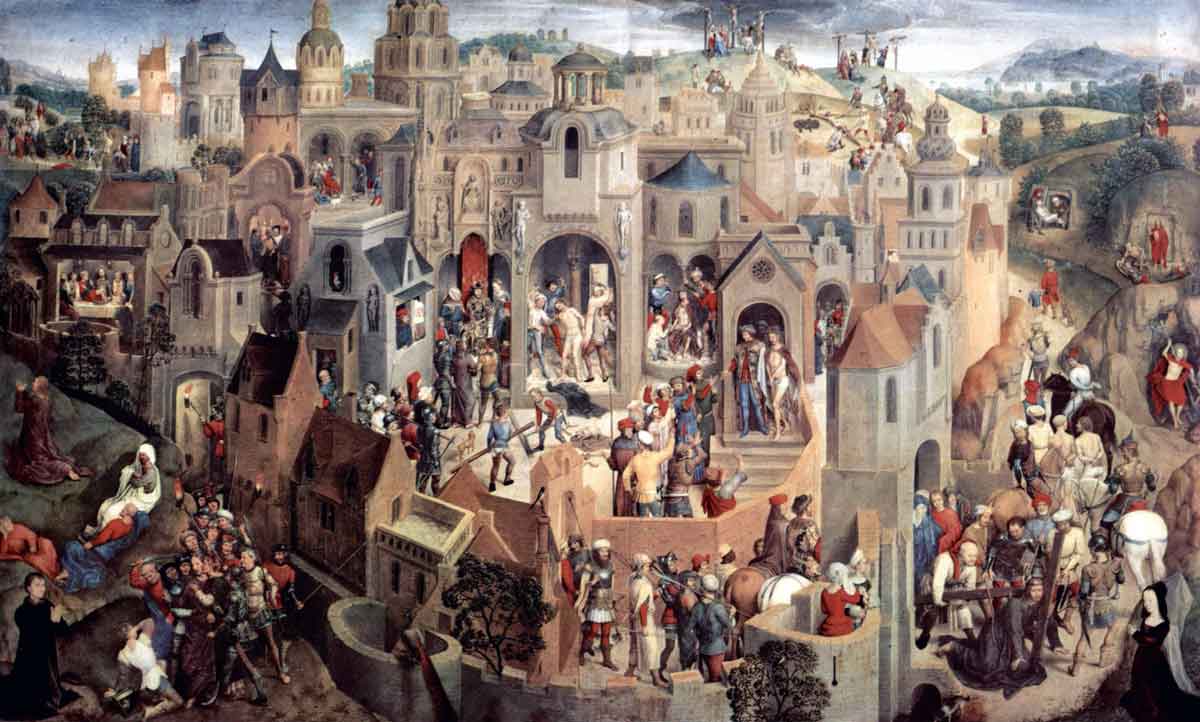The Enchantment of Catholicism
By Guest Author, Terri Aluise
Fr. Andrew Greeley wrote in his book The Catholic Imagination:
Catholics live in an enchanted world, a world of statues and holy water, stained glass and votive candles, saints and religious medals, rosary beads and holy pictures. But these paraphernalia are mere hints of a deeper and more religious sensibility which inclines Catholics to see the Holy lurking in creation. The world of the Catholic is haunted by a sense that objects, events and persons of daily life are revelations of Grace.
It is this “enchanted world” that has always drawn me into the faith. I was thinking about this enchanted world recently for a number of reasons, but mainly because of a discussion in a liturgy committee meeting I attended at my parish about the Feast of Corpus Christi. The liturgy committee is comprised of representatives from different ministries within the church. Usually our pastor attends, as well as the musical director, a “prayers of the faithful” writer, an usher, a Eucharistic Minister, the church decorator and a lector (me). At our last meeting, we were trying to figure out how to celebrate Corpus Christi in a way that was reverent, and yet plausible given the fact that most parishioners get antsy when Mass goes over an hour. Every year, it is the same discussion. I suggest we do a procession outside, around the church, with the priest holding up the Eucharist in a monstrance – and everyone else tells me why it’s a bad idea. “What if it rains?” is usually the response. Or “What if it takes too long? We have another Mass right after this.” All legitimate concerns, no doubt. So usually we agree that the priest will do a procession indoors after Mass, by himself, with the Eucharist in the ciborium.
“Enchanting”? Meh.
Back in the day (meaning time immemorial up until Vatican II), Catholics used to make a big deal out of the Feast of Corpus Christi. The feast celebrates the Real Presence of Christ in the Eucharist (“Corpus Christi” being Latin for “Body of Christ”). Yes, we go to Mass to hear the Word proclaimed and to hear a homily, but the main reason we are there is to partake in the divine life of Christ, is it not? That’s why everyone patiently waits until they receive the Eucharist before they leave in hurry before the final blessing. They want to get what they came for. So since the Eucharist is the center of our worship, why not celebrate its feast day with more vigor?
Perhaps Catholics would appreciate the feast if they knew its history. There are conflicting reports as to how the feast began. Some say the feast began with a Belgian Augustinian nun named St. Juliana of Mont Cornillon (1193 – 1258 A.D.). From her youth, she had a great veneration for the Blessed Sacrament. This veneration is said to have led to vision she had of the Church under the appearance of the full moon. The moon had one dark spot, signifying the lack of a solemnity. She made her idea known to her bishop, who in turned had it relayed to Pope Urban IV. Others say that it began with a German priest named Peter of Prague, who on a pilgrimage to Rome, had an unusual experience. Although he was a holy and devout man, he harbored doubts about the real presence of Christ in the Eucharist. He stopped by the Church of St. Christina in 1263 A.D. to offer mass and right after he consecrated the host, blood began to drip from it onto the corporal. He immediately went to see Pope Urban IV, who was in Orvieto at the time, to show him the host and corporal. It was declared a miracle and the corporal can still be seen today in the Cathedral in Orvieto.
Needless to say, Pope Urban IV issued a Bull in 1264 A.D. instituting the feast. He enlisted St. Thomas Aquinas to write sequence for the Mass, Lauda Sion Salvatorem. Aquinas also wrote the number of chants to follow the Mass in a procession, including the beautiful Tantum Ergo Sacramentum and Adoro Te Devote.
As child of the post-conciliar church, I had never even heard of this feast day until I was in a secular college studying theater. We were studying the medieval morality and mystery plays. Plays such as Everyman (which uses allegorical characters to examine the question of Christian salvation) and Doctor Faustus (a character who makes a deal with the devil). The whole town participated in the plays, with each guild acting in a play that pertained to their trade. For instance, fisherman might do a play about Noah and the flood. In any case, these plays were usually performed during the week-long celebration of the Feast of Corpus Christi. The celebration not only including plays, but also songs and processions preceded by the laying of rose pedals before the Blessed Sacrament.
Obviously, the middle ages were a simpler time. It was an agricultural society that was more in tune with nature and the seasons. Their whole lives centered on the feast days of the church. They didn’t have a million things distracting them, like smart phones, television, the internet, etc. They didn’t skip Mass because their kid had a soccer game or dad got a free pass to golf. But it is precisely because of these distractions that we need to take time out and reflect on the mystery of God.
 In 2013, Pope Francis led a Corpus Christi procession through the streets of Rome after Mass at St. John Lateran to St. Mary Major. I imagine this is what he had in mind when he spoke about bringing back popular pieties in his encyclical Evangelii Gaudium (The Joy of the Gospel).
In 2013, Pope Francis led a Corpus Christi procession through the streets of Rome after Mass at St. John Lateran to St. Mary Major. I imagine this is what he had in mind when he spoke about bringing back popular pieties in his encyclical Evangelii Gaudium (The Joy of the Gospel).
If the Pope can do a procession, I don’t see why we can’t. I suppose many Catholics would feel self-conscience and nervous parading around in a public procession, having to deal with all the condescending stares of those driving by wondering “What in the world are those crazy Catholics doing?” But that’s just the point. Our faith is not a secret that we keep to ourselves. It is not a private possession. On Sunday, we celebrate Pentecost, when the Holy Spirit descended upon the apostles and Mary. Their mission? To make disciples of all nations. In light of our baptism, it is our mission as well. A Corpus Christi procession shows our incarnational, sacramental gratitude to God. It creates mystery and wonder. We show the world that we are part of it, but not of it.
And it is enchanting.
 Terri Aluise and her family are parishioners of St. Benedict Church in Chicago, Illinois. Active in Catholic circles, Mrs. Aluise is a wife, mother, and avid client of St. Joseph.
Terri Aluise and her family are parishioners of St. Benedict Church in Chicago, Illinois. Active in Catholic circles, Mrs. Aluise is a wife, mother, and avid client of St. Joseph.
This article, The Enchantment of Catholicism is a post from The Bellarmine Forum.
https://bellarmineforum.org/the-enchantment-of-catholicism/
Do not repost the entire article without written permission. Reasonable excerpts may be reposted so long as it is linked to this page.


There is no faith more interesting.. I love our enchanted world.
ps, How could you never have heard of this feast day even in the post V2 church? In the pre V2 church we had great processions – the little girls in our 1st communion dresses dropped flowers (mums, they smelled so good) and the priest with the monstrance followed with the altar boys and candles and clouds of incense. Glorious.